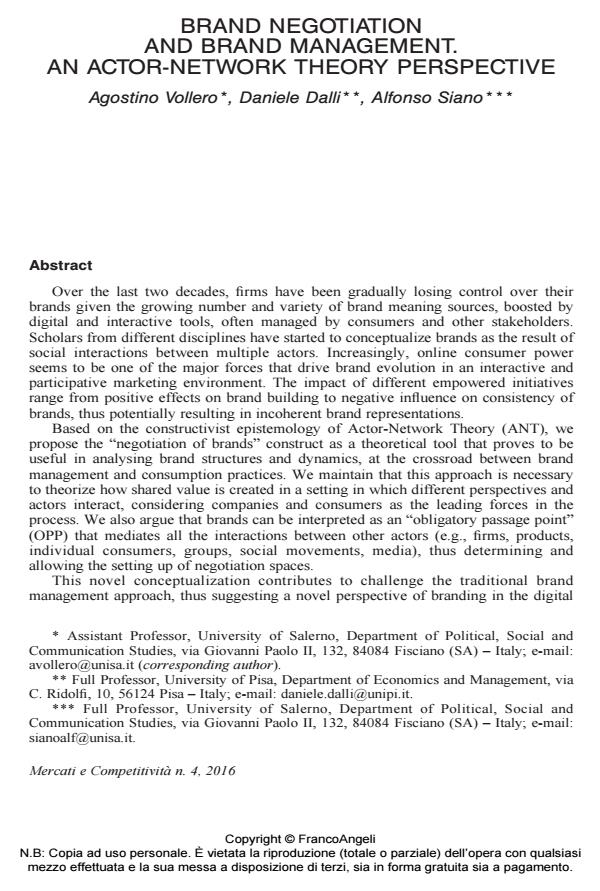Brand negotiation and brand management. An actor-network theory perspective
Titolo Rivista MERCATI & COMPETITIVITÀ
Autori/Curatori Agostino Vollero, Daniele Dalli, Alfonso Siano
Anno di pubblicazione 2016 Fascicolo 2016/4
Lingua Inglese Numero pagine 19 P. 23-41 Dimensione file 139 KB
DOI 10.3280/MC2016-004003
Il DOI è il codice a barre della proprietà intellettuale: per saperne di più
clicca qui
Qui sotto puoi vedere in anteprima la prima pagina di questo articolo.
Se questo articolo ti interessa, lo puoi acquistare (e scaricare in formato pdf) seguendo le facili indicazioni per acquistare il download credit. Acquista Download Credits per scaricare questo Articolo in formato PDF

FrancoAngeli è membro della Publishers International Linking Association, Inc (PILA)associazione indipendente e non profit per facilitare (attraverso i servizi tecnologici implementati da CrossRef.org) l’accesso degli studiosi ai contenuti digitali nelle pubblicazioni professionali e scientifiche
Over the last two decades, firms have been gradually losing control over their brands given the growing number and variety of brand meaning sources, boosted by digital and interactive tools, often managed by consumers and other stakeholders. Scholars from different disciplines have started to conceptualize brands as the result of social interactions between multiple actors. Increasingly, online consumer power seems to be one of the major forces that drive brand evolution in an interactive and participative marketing environment. The impact of different empowered initiatives range from positive effects on brand building to negative influence on consistency of brands, thus potentially resulting in incoherent brand representations. Based on the constructivist epistemology of Actor-Network Theory (ANT), we propose the "negotiation of brands" construct as a theoretical tool that proves to be useful in analysing brand structures and dynamics, at the crossroad between brand management and consumption practices. We maintain that this approach is necessary to theorize how shared value is created in a setting in which different perspectives and actors interact, considering companies and consumers as the leading forces in the process. We also argue that brands can be interpreted as an "obligatory passage point" (OPP) that mediates all the interactions between other actors (e.g., firms, products, individual consumers, groups, social movements, media), thus determining and allowing the setting up of negotiation spaces. This novel conceptualization contributes to challenge the traditional brand management approach, thus suggesting a novel perspective of branding in the digital era that is grounded in the mediations between value and meaning contributions put forward by different actors. This approach becomes critical in current interactive marketplaces as it might allow brand managers to nurture different paths of brand development through the reconciliation of various stakeholders’ instances.
Parole chiave:Brand management; actor-network theory (ANT), consumer power; negotiation.
- IMC in digitally-empowering contexts: the emerging role of negotiated brands Agostino Vollero, Don E. Schultz, Alfonso Siano, in International Journal of Advertising /2019 pp.428
DOI: 10.1080/02650487.2018.1535221 - From brand control to brand co-creation: An integrated framework of brand paradigms and emerging brand perspectives Alfonso Siano, Agostino Vollero, Alessandra Bertolini, in Journal of Business Research /2022 pp.372
DOI: 10.1016/j.jbusres.2022.08.001 - What is happening to the brand? Maria Vernuccio, in MERCATI & COMPETITIVITÀ 4/2018 pp.7
DOI: 10.3280/MC2018-004001
Agostino Vollero, Daniele Dalli, Alfonso Siano, Brand negotiation and brand management. An actor-network theory perspective in "MERCATI & COMPETITIVITÀ" 4/2016, pp 23-41, DOI: 10.3280/MC2016-004003